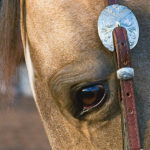Proper winter preparation is important to make sure you, your horse, and your barn are ready for the coming winter weather. This checklist of fall horse chores will help you organize your winter preparation effort.
Barn-Chore Checklist

Stock up on feed and bedding. Winter weather can close roads unexpectedly, preventing you from reaching the feed store or preventing delivery trucks from reaching the feed store. If you normally keep one week’s worth of feed and bedding on hand, lay in enough supplies to keep your horse fed and dry for three to four weeks.
Check your horse’s winter blanket. Does your horse wear a winter blanket to protect him from the winter weather? As part of your winter preparation, check it over, and repair it now, especially if you clip your horse in fall and ride him through the winter. A clipped horse must wear a blanket in winter to replace the warmth provided by his lost haircoat. Even an unclipped horse might need a blanket at some point, for extra warmth or protection against a cold wind, wet snow, or both.
Spiff up your barn. If you need new rubber mats in your stalls, new gravel around your barn, a new hose or even light bulbs, take care of those needs now. Moving heavy stall mats and standing on ladders is difficult enough in summer; short days, icy weather and cold, and stiff fingers make these tasks almost impossible.
Invest in a storage cabinet. Stash your winter supplies from warm gloves to ice melt in an inexpensive resinstorage cabinet. Clean your water heaters, tank de-icers, and heated water buckets, and put them in the cabinet so you can easily find them.
Keep a grooming vac handy. Don’t lock away your equine vacuum cleaner for the winter use it to blow-dry your horse’s coat if rain, snow or unusual exertion wet him to the skin.
Use rubber buckets. Some ice-removing techniques can cause plastic buckets to shatter. Rubber buckets, on the other hand, are nearly indestructible and will survive even if you slam them against the ground, turn them upside down, and jump on them.
Pasture-Chore Checklist

Analyze pasture soil. Take samples of your pasture soil, and have them analyzed. Lime and fertilize pastures based on the analysis. In late fall, re-seed or overseed your pastures. If you haven’t been happy with your pasture grasses, solicit advice from your local extension agent on mixing cold-season and warm-season grasses, and/or adding legumes to the mix.
Walk your fence line. Repair any damage before the temperature drops and the ground freezes, especially if fence posts are involved. Earth and wire are both easier to work with in warmer weather.
Clean your run-in shed. Routine cleaning of your pasture’s shed and sacrifice area can become difficult in winter, and there may be weeks when snow accumulating or melting makes manure removal impossible. Give yourself and your horses an edge by doing a thorough fall cleanout.
Drain and prep wet areas. Were there wet, muddy or flooded spots in the high-traffic around your pasture gates and water tanks this spring and summer? To help prevent these areas from turning into ice, raise and level them with a load of gravel or road pack. You don’t want your horse skidding and falling on ice.
Jessica Jahiel, PhD, is an internationally recognized clinician and lecturer, and an award-winning author of books on horses, riding and training. Her digital newsletter is a popular worldwide resource.





